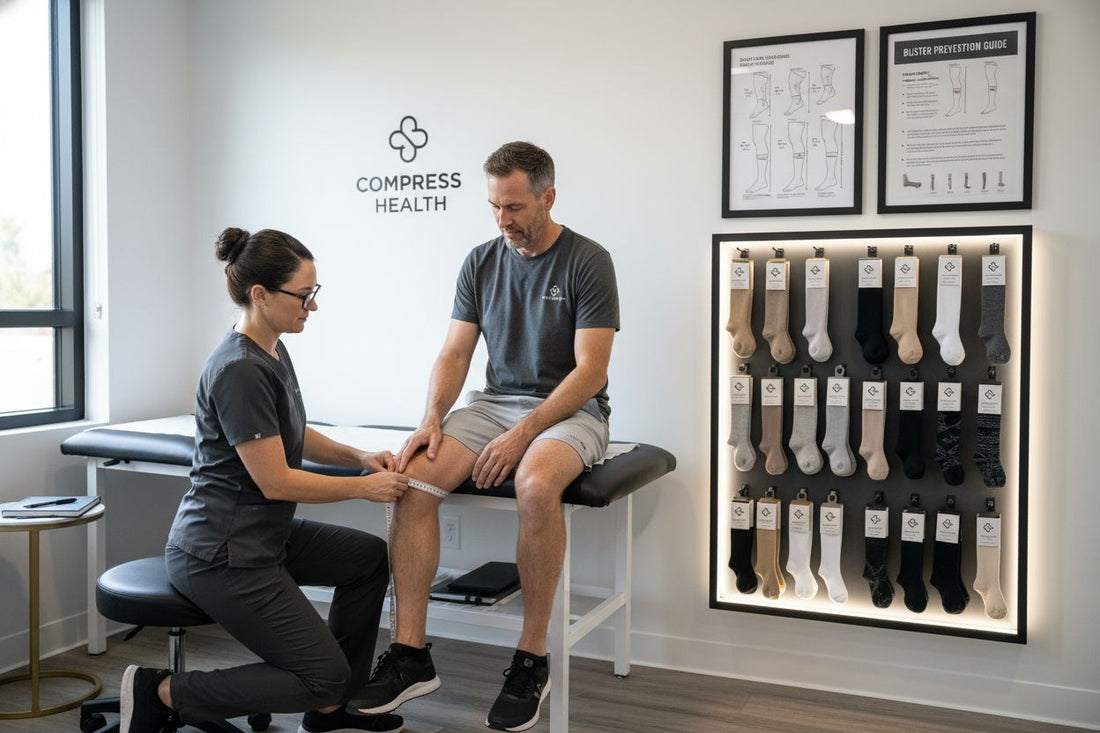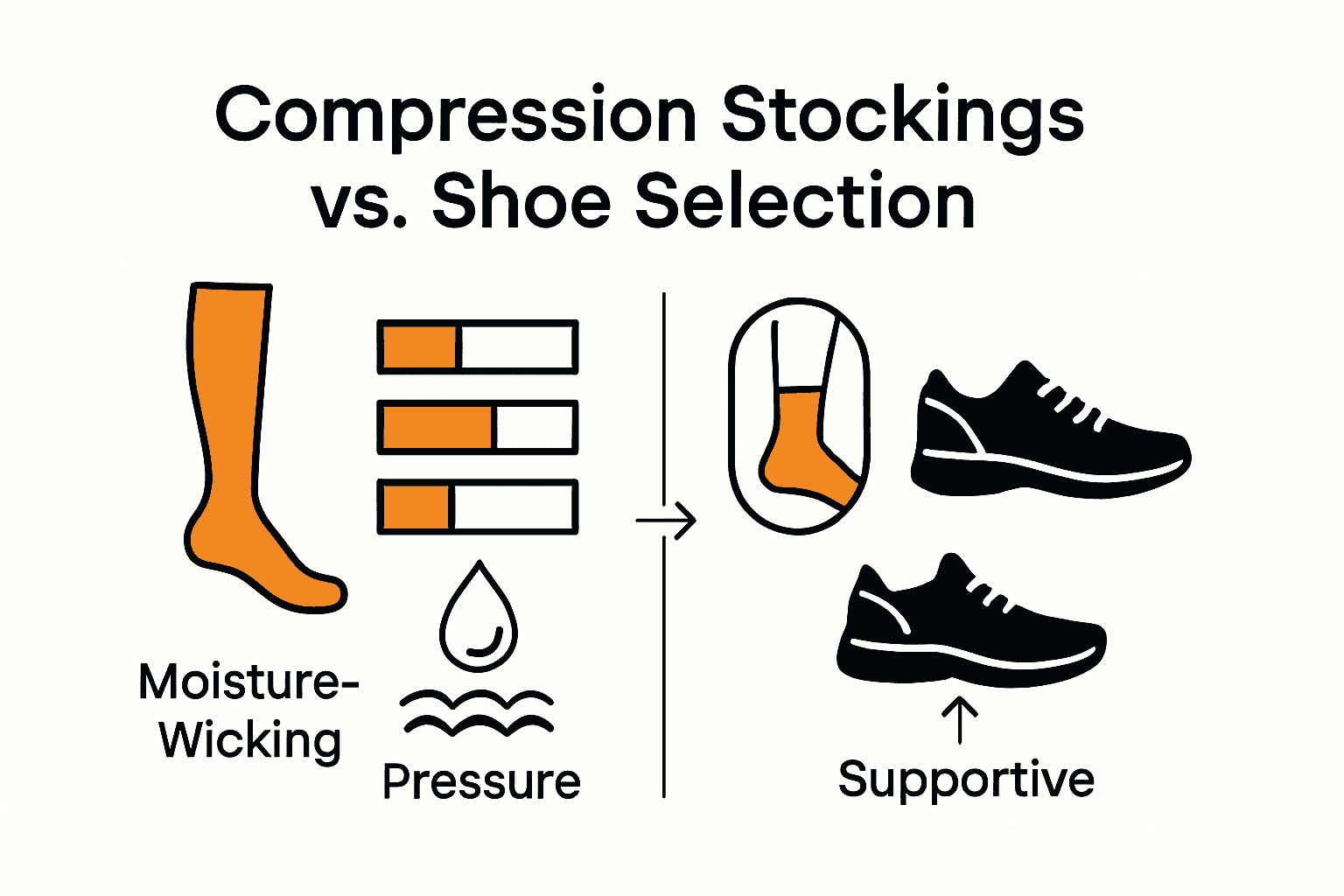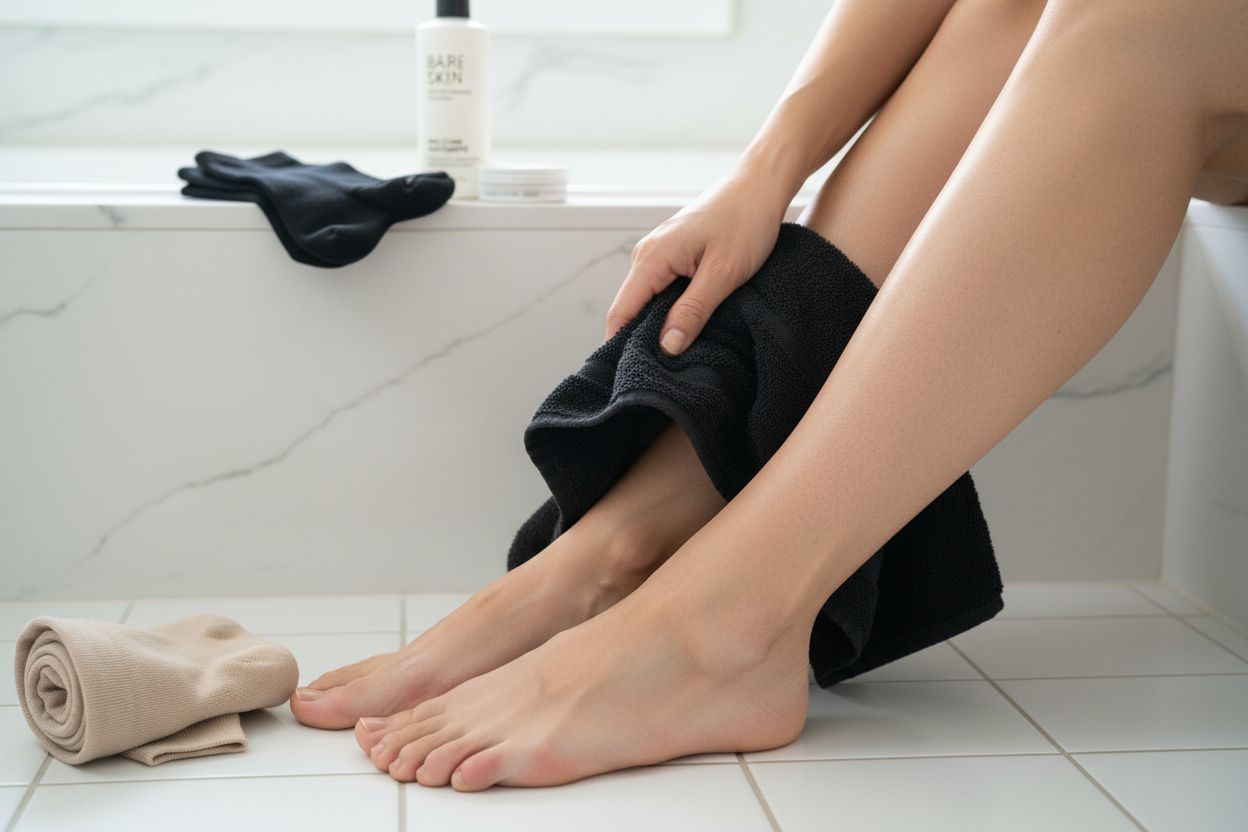
How to Avoid Blisters Naturally with Compression Stockings
Share
Did you know that over 2 million people each year experience skin problems from improper use of compression stockings? Choosing and wearing compression stockings the right way can be the difference between lasting comfort and painful blisters. For anyone who depends on compression therapy, knowing each careful step helps keep your legs healthy and pain-free while reducing the risk of irritation and skin damage.
Quick Summary
| Key Point | Explanation |
|---|---|
| 1. Choose the right compression stockings | Measure legs in the morning for accurate size and select appropriate compression levels to enhance comfort and circulation. |
| 2. Prepare skin before wearing stockings | Clean and dry feet thoroughly, moisturize gently, and apply anti-chafing protection to minimize friction and irritation. |
| 3. Apply stockings correctly for effectiveness | Use the inside-out method for smooth application, ensuring no wrinkles or bunching to maintain even compression throughout wear. |
| 4. Monitor comfort throughout the day | Check skin for redness, discomfort, and adjust stockings as needed to maintain optimal comfort and therapeutic benefits. |
| 5. Perform daily skin checks for irritation | Inspect feet regularly to detect early signs of irritation or skin changes, allowing for prompt adjustments or medical consultation. |
Table of Contents
- Step 1: Select Appropriate Compression Stockings And Footwear
- Step 2: Prepare Skin And Toes For Optimal Protection
- Step 3: Apply Stockings Correctly For A Smooth Fit
- Step 4: Monitor Comfort And Adjust Throughout The Day
- Step 5: Check Feet Regularly For Early Signs Of Irritation
Step 1: Select appropriate compression stockings and footwear
Picking the right compression stockings and matching footwear is crucial for preventing blisters and ensuring maximum comfort during wear. This step will help you make smart choices that protect your skin and support healthy circulation.
Start by understanding compression strength. According to thrombosis research, you want to measure your legs accurately and choose the right compression level. Ideally, take these measurements in the morning before any swelling occurs. Compression stockings range from mild to extra firm pressure levels, so knowing your specific needs matters.
Focus on material and construction when selecting your stockings. Read our comprehensive compression stockings fitting guide to understand the nuances. Look for moisture-wicking synthetic blends that offer seamless or flat-seam designs. These features dramatically reduce friction against your skin.
When trying on compression stockings, ensure they fit smoothly without any wrinkles. Wrinkles create friction points that can quickly lead to painful blisters. The stocking should feel snug but not painfully tight. Think of it like a second skin that gently supports your legs.
Pro Tip: Always put on compression stockings first thing in the morning when leg swelling is minimal for the most comfortable fit.
Your footwear matters just as much as the stockings themselves. Choose shoes that complement your compression wear select options with smooth interior linings that won’t rub against the stocking material. Athletic shoes with good arch support and minimal interior seams work best.
By carefully selecting your compression stockings and matching them with appropriate footwear, you’re setting yourself up for blister-free comfort and improved leg health.
Here’s a comparison of key factors to consider when selecting compression stockings and footwear:

| Factor | Compression Stockings | Footwear |
|---|---|---|
| Pressure Levels | Mild Moderate Firm Extra Firm |
Not applicable |
| Material & Construction | Moisture-wicking blends Seamless/flat seams |
Smooth interior lining Minimal interior seams |
| Fit | Snug, no wrinkles Feels like second skin |
Good arch support Proper sizing |
| Timing | Measure/apply in morning | Wear with stockings throughout day |
| Comfort Check | Smooth, even pressure | No rubbing or friction areas |
Step 2: Prepare skin and toes for optimal protection
Protecting your skin before putting on compression stockings is like creating a protective shield that prevents irritation and potential blisters. This step focuses on preparing your skin and toes to ensure maximum comfort and minimal friction.
Start with clean and completely dry feet. According to research from wellbeing experts, your skin needs to be thoroughly dried before putting on compression stockings. Take time to wash your feet carefully and then pat them completely dry using a soft towel.
Moisturizing is key. Learn more about preventing foot discomfort and understand how proper skin preparation can make a significant difference. Choose a mild fragrance-free moisturizer and apply it in gentle downward strokes. According to NHS guidelines, allow the moisturizer to absorb fully before putting on your compression stockings.
For areas prone to friction create an additional protective barrier. Apply a thin layer of anti-chafing balm or petroleum jelly on spots that typically experience rubbing. This extra step can dramatically reduce the chances of developing painful blisters.
Pro Tip: Consider wearing a thin moisture-wicking liner sock underneath your compression sock for added protection and comfort.
Pay special attention to your toes and any areas with existing skin sensitivity. Smooth out any rough patches and ensure your skin is in the best possible condition before putting on your compression stockings.
By taking these preparatory steps you are setting yourself up for a comfortable and blister-free experience with your compression wear.

Step 3: Apply stockings correctly for a smooth fit
Applying compression stockings might seem tricky at first, but with the right technique, you can achieve a smooth fit that maximizes comfort and therapeutic benefits. This step will walk you through the precise method to put on your stockings without creating uncomfortable wrinkles or potential skin irritation.
Learn the full technique for putting on compression stockings and master the art of smooth application. According to Mayo Clinic research, the key is to turn your stockings inside out at the heel before starting. This technique helps you control the fabric and reduce potential bunching.
Begin by sitting down in a comfortable chair with good lighting. Gather your stockings and make sure your feet are completely dry. Carefully roll the stocking down to the heel area turning it inside out in the process. Gently place your foot inside and start smoothing the fabric over your foot and ankle.
Slowly unroll the stocking up your leg using both hands to guide the fabric. As you pull the stocking upward, use your fingers to smooth out any potential wrinkles or folds. The goal is to create a uniform pressure that feels snug but not restrictive.
Pro Tip: Consider using rubber gloves or a specialized donning aid if you have difficulty pulling the stockings up smoothly.
Take a moment to check that the seams are straight and the stocking sits evenly on your leg. No bunching or folding should be present. If you notice any areas of uneven tension or discomfort adjust the stocking carefully.
By mastering this careful application technique you will ensure your compression stockings provide optimal support and reduce the risk of blisters or skin irritation.
Step 4: Monitor comfort and adjust throughout the day
Wearing compression stockings is not a set-it-and-forget-it experience. Monitoring your comfort and making timely adjustments is crucial to ensure you receive the maximum therapeutic benefits without compromising your skin health. This step will help you stay proactive about your comfort and recognize any potential issues early.
Discover essential tips for compression stocking care and learn how to make your compression therapy more effective. According to WebMD medical research, being vigilant about your body’s response is key. Pay close attention to how your legs feel throughout the day.
Start by checking your skin periodically. Look for signs of potential problems like unusual redness, unexpected pain, or areas of discomfort. These could indicate that your stockings might need readjustment. Sometimes minor shifts during movement can cause slight bunching or uneven pressure that needs quick correction.
During the first few hours of wear, do a few comfort checks. Sit down, stand up, walk around and notice how the stockings feel. Are they maintaining consistent pressure? Do they feel smooth against your skin? Your body will provide feedback about the fit and comfort level.
Pro Tip: If you experience persistent discomfort or notice skin discoloration, remove the stockings and consult your healthcare provider.
Make small adjustments as needed. Gently smooth out any wrinkles, reposition the stocking if it has shifted, and ensure even compression. Your goal is maintaining consistent comfort and support throughout your daily activities.
By staying attentive and responsive to your body’s signals, you will maximize the benefits of your compression therapy while keeping your skin healthy and comfortable.
Step 5: Check feet regularly for early signs of irritation
Preventing blisters and skin complications requires consistent and careful monitoring of your feet when wearing compression stockings. This crucial step helps you catch potential issues before they develop into more serious problems.
Learn more about preventing foot health complications and understand the importance of daily skin assessments. According to Mayo Clinic research, daily skin inspections are your first line of defense against potential compression stocking related issues.
Make your skin check a consistent daily ritual. Remove your compression stockings and examine your entire foot carefully under good lighting. Look for any changes in skin color like unusual redness, unusual texture, or areas of potential irritation. Pay special attention to areas that experience the most friction like your heels, ankles, and between your toes.
Feel your skin thoroughly and note any soreness or sensitivity. According to NHS guidelines, early detection of skin changes can prevent progression to more serious conditions like blisters or ulcers. Run your fingers gently across your skin checking for any bumps, warm spots, or areas of tenderness.
Pro Tip: Use a small handheld mirror to help you see areas that are difficult to inspect directly, like the bottoms of your feet and between your toes.
Document any changes you notice. If you observe persistent redness, skin breakdown, or experience ongoing discomfort, contact your healthcare provider promptly. These could be signs that your compression stockings need adjustment or that you require medical evaluation.
By making these daily checks a habit, you are taking proactive steps to maintain your foot health and prevent potential complications from compression therapy.
Experience Blister-Free Comfort with Professional Compression Solutions
Struggling to avoid blisters and skin irritation while using compression stockings? You are not alone. Many people coping with conditions like varicose veins, lymphedema, or pregnancy-related swelling worry about choosing the right fit and protecting sensitive skin. This article outlined how critical proper sock selection, skin prep, smooth application, and ongoing care are for healthy, comfortable legs. But finding medical-grade stockings you can trust should not be overwhelming or risky.
At Fit Stockings, you will discover a curated range of compression stockings designed for therapeutic support and all-day comfort. With trusted brands, detailed size guides, and a wide variety of styles and pressures, you can choose the perfect match for your needs. Explore our step-by-step application tips or shop confidently knowing that your journey to healthy, blister-free legs starts here. Visit Fit Stockings today to find your ideal solution and start feeling the difference now.
Frequently Asked Questions
How can I select the right compression stockings to prevent blisters?
Choosing the right compression stockings involves understanding the appropriate pressure levels for your needs and focusing on materials that reduce friction. Measure your legs in the morning for the best fit and opt for moisture-wicking blends with seamless designs to minimize irritation.
What steps should I take to prepare my skin before wearing compression stockings?
Prepare your skin by washing and thoroughly drying your feet, then applying a mild, fragrance-free moisturizer to help prevent irritation. For increased protection, consider applying anti-chafing balm to areas prone to friction before sliding on your compression stockings.
How can I smoothly apply compression stockings to avoid wrinkles?
To apply compression stockings without wrinkles, turn them inside out at the heel and gently place your foot inside, then smoothly unroll the fabric up your leg while using both hands to avoid bunching. Ensure that the fit feels snug but not tight, achieving a comfortable and even pressure across your legs.
What should I monitor while wearing compression stockings to prevent skin irritation?
Regularly check your skin for signs of irritation, such as unusual redness or soreness, especially in friction-prone areas like heels and ankles. Perform these checks periodically, making adjustments to your stockings as needed to maintain consistent comfort throughout the day.
How often should I inspect my feet for signs of blisters while using compression stockings?
Inspect your feet daily after removing your compression stockings to catch any early signs of blisters or skin irritation. Make this a regular habit, as early detection can significantly reduce the risk of developing more serious complications.

